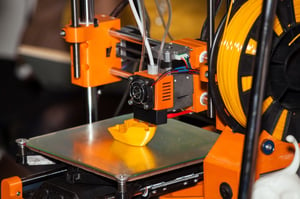 From developing prototypes in the 1980s to creating complex, precise, and functional products in the 2020s, additive manufacturing (AM) has come a long way. Demand has been driven by advancements in technologies and applications in multiple industries.
From developing prototypes in the 1980s to creating complex, precise, and functional products in the 2020s, additive manufacturing (AM) has come a long way. Demand has been driven by advancements in technologies and applications in multiple industries.
Prototypes were used to scale the models of finalized products nearly four decades ago. However, the scenario has now completely changed.
Additive manufacturing has become known as 3D printing, as it leads to the development of three-dimensional objects. Currently, the healthcare sector, automotive companies, and the military are utilizing AM to create objects, products, and shapes for real-life applications. The use of AM is expanding in various sectors to include 3D-inplants in medical applications and manufacturing spare parts in automobile applications. With further advancements in technologies, the development of innovative printers, and investments in R&D activities, these applications are expected to expand further.
This article provides a comprehensive view of the global additive manufacturing market size and forecast, its applications, new product launches, development activities, and market drivers and opportunities.
Additive Manufacturing: A Brief Introduction
Additive manufacturing (AM), also known as 3D printing or additive layer manufacturing (ALM), is a technology for developing three-dimensional objects through the deposition of layers upon layers. Generally, 3D scanners or computer-aided design (CAD) software can be used to design objects. Once a design is created using 3D scanning or CAD software, it can be loaded into an AM machine or 3D printer to develop precise geometrical objects layer by layer.
Different technologies, including fused deposition modeling, selective laser sintering, inkjet printing, electron beam melting, laser metal deposition, and others, can be utilized to create 3D-printed objects. Materials such as ceramic, plastic, and polymer can be used to develop precise objects. Desktop and industrial 3D printers are usually utilized for developing objects based on applications.
Global Additive Manufacturing Market Growth
According to a report published by Next Move Strategy Consulting, the global additive manufacturing market size is projected to reach $83.56 billion by 2030, witnessing a CAGR of 21.2% from 2022 to 2030. The surge in adoption in healthcare, automotive, and other industries along with advancements in different AM technologies are expected to drive the market growth. The increase in investments by market players and expansion in various regions are expected to present new opportunities for the market in the coming years.
Key Applications of Additive Manufacturing
The application scope of AM is increasing in the healthcare sector. Surgeons and healthcare professionals are utilizing AM to develop implants and prostheses to cater to the unique and specific needs of individual patients. Moreover, AM objects help surgeons practice complex surgical processes, which, in turn, improves safety, accuracy, and speed of operation. Pharmaceutical companies are utilizing 3D printing to manufacture capsules and medicines cost-effectively and rapidly.
The automotive sector also utilizes AM to create physical parts. Original equipment manufacturers (OEMs) are testing the possibilities of AM in developing different spare parts that are effective, customized, and provide high performance. In addition, aerospace, construction, and defense sectors are utilizing AM for developing customized objects rapidly as per the requirement.
Major Driving Factors and Challenges
The cost-effective manufacturing process and rapid pace of development of AM are major driving forces behind its adoption in different industries, such as healthcare, automotive, aerospace, and others. In addition, technological advancements that improve object accuracy and precision led to a surge in its adoption worldwide. These factors drive growth in the additive manufacturing industry.
However, lack of standardization poses challenges to the growth of the market. On the other hand, the rise in investments in research and development (R&D) activities by major market players and research institutes creates new opportunities in the coming years. The introduction of advanced 3D printers that can create prototypes for the electronics and semiconductors industry also presents new avenues for the market growth.
Countries & Regions Experiencing Market Growth
The high adoption of AM in the construction, automotive, and aerospace & defense industries in the North American region is driving market growth. This region is expected to maintain its dominance in the global market by 2030, according to the report by Next Move Strategy Consulting. Another report states that the North America additive manufacturing market size is forecast to reach $28.83 billion by 2030. In this region, the U.S. additive manufacturing market is expected to account for the largest market share in North America, with the estimated market value rising to $22.26 billion by 2030. The increase in adoption by pharmaceutical companies and the medical sector is expected to drive the market growth in this region.
The European region is expected to register steady growth in the coming years, owing to the high adoption in the defense sector and an increase in investments by market players. The surge in government initiatives and investments in 3D printing applications for the military are projected to drive the market growth. Furthermore, Germany is expected to witness steady growth in this region and become a large market for AM, owing to increased startups and the launch of innovative printers.
Top Additive Manufacturing Companies
Top companies operating in the additive manufacturing industry include General Electric, Stratasys, 3D Systems, Inc., Proto Labs, Formlabs, Inc., Desktop Metal, Inc., Xometry, Inc., Markforged Holding, Shapeways Holdings, Inc., and others. These companies are adopting different strategies such as new printer launches, partnerships, expansion, investments in R&D activities, and others to raise their market stakes, accelerate manufacturing activities, and maintain their leadership positions globally.
For instance, Stratasys joined hands with Evonik to acquire materials for additive manufacturing applications. As per the partnership agreement, Evonik will provide ready-to-use photopolymer materials to Stratasys. This partnership is expected to raise the quality of 3D-printed products and provide advanced & better products to customers.
Companies from Germany are developing innovative printing machines. EOS GmbH launched the EOS M 290 1kW machine. This machine is aimed at designing and developing copper inductors and copper alloy-based objects using additive manufacturing. It provides high cooling channel optimization and reduces power consumption throughout the product lifecycle. It has a wide range of applications in the space, transportation, and energy sectors. Along with top companies, startups also accelerated their efforts to raise their stakes in the market and cater to a wide customer base.
Where to Learn More
For detailed additive manufacturing industry analysis, see the additive manufacturing market research reports by Next Move Strategy Consulting available on MarketResearch.com, which cover a wide range of regions and countries.
About the Author
 Sunanda Ghosh is a researcher at Next Move Strategy Consulting, with over three years of experience. Her curiosity for emerging trends drives her to decipher market complexities, crafting actionable insights. With a passion for collaborating with diverse global clients, Sunanda has successfully delivered numerous market reports across multiple domains.
Sunanda Ghosh is a researcher at Next Move Strategy Consulting, with over three years of experience. Her curiosity for emerging trends drives her to decipher market complexities, crafting actionable insights. With a passion for collaborating with diverse global clients, Sunanda has successfully delivered numerous market reports across multiple domains.
Next Move Strategy Consulting is a premier market research and management consulting firm committed to delivering high-quality market research reports across 10 different industry verticals. Our analysts are constantly tracking various high-growth markets and identifying hidden opportunities in each sector.

